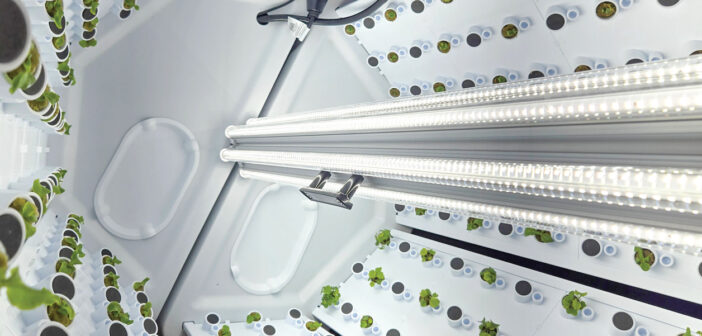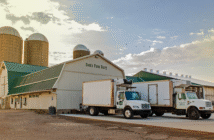Many people would agree that there is something very satisfying about planting, nurturing and harvesting their own veggies – and finally eating the fresh produce simply tastes better.
This year, students at Swartz Creek Middle School are learning this as they work with their first ever hydroponic gardening system. In addition to enjoying fresh lettuce and other produce in their school lunches, growing their own could soon take a significant bite out of the Swartz Creek Schools food budget.

Project leader Tony Delgado has collaborated with District STEM Coordinator Michele Bielby to get
the hydroponic farm up and growing.
The system was also expected to be in place by the end of November at Swartz Creek High School.
Hydroponics is the technique of growing plants in a water-based nutrient solution rather than soil. This type of farming is an effective method of growing plants indoors, and has its own various advantages, including health benefits. It allows growers to produce nutrient-rich plants much faster without the use of pesticides.
The hydroponic system was implemented at Swartz Creek Middle School by Tony Delgado, Director of Dining Services for Swartz Creek Schools. “I grew up in Genesee County, graduated from Davison High School and U of M – Flint,” he shared. “I spent most of my career in restaurant management. I made the change to school food service because I have two young children, and needed a job that worked with their schedule. Additionally, I was commuting 45 minutes to work one way – so, I am happy to be so much closer to home.”
Delgado explained that he attended a conference in Denver, CO during the summer of 2023, when he connected with a company called Fork Farms. “They had a compact indoor hydroponic garden system that worked well in schools and offered a lot in the way of curriculum. I had thought about how and where to start; but I finally connected with our District STEM Coordinator, Michele Bielby. She was very interested and so, we started to collaborate. We got our Flex Farm system at the end of September, planted at the beginning of October and had one harvest the week before Halloween.

Rockwool (a rock-based mineral fiber) is the hydroponic grow medium used in the Flex Farm. Seeds are directly sowed into the rockwool cubes for germination.
“Right now, we have not fully integrated the project into the curriculum. But, after this first harvest, the kids will be assisting in every step. We wanted to get our feet wet before fully adding it as a fixture in their grading.” The system includes ongoing support and free, integrated STEM learning tools.
So far, they have successfully grown a few different varieties of lettuce, kale and basil. The lettuce has been used to make wraps, sandwiches and salads. “Lettuce is one of the easiest and fastest crops to grow,” Delgado noted. “But we will start expanding to others once we feel a little more comfortable.”
Most produce is ready to be harvested in 28 days. “We are looking to stagger our planting with the next grow to have a more consistent supply of crops,” Delgado added. “But, if we were to clear it all out in one, we could get somewhere near six to seven full bus tubs of lettuce!”
The Swartz Creek Middle School system is located in its STEAM (Science, Technology, Engineering, Art and Mathematics) Lab and the one that is coming to the high school will be set up in its lab, as well. It takes up roughly ten square feet of space, according to Delgado.

Swartz Creek School Board President Carrie Germaine happily helps with the lettuce harvest.
“The new systems require very little electricity – the energy-efficient LEDs use very little power compared to the old grow lights,” he added. The water is recycled repeatedly throughout the grow process. “We add some water due to evaporation and absorption by the plants themselves. The lettuce literally squirted when we broke it off, because it was so hydrated!” he exclaimed. One to three times per week, they add water and test the nutrients to make sure the crops are getting everything they need.
In the event of a power outage, the hydroponic system can go a day or so without power. “But longer than that, and we would have to consider moving the system to another location, which is not hard, or adding a temporary generator.”
The total system and starter kit cost roughly $6,000. A case of lettuce costs about $40, so the school would need to produce about 150 cases of lettuce to recoup the cost, Delgado said.
“It could save just our high school around $120 a week.”
The portable Flex Farm system can be easily expanded. “You can link up to four, so you can run them on the same timer and only have to test and replenish one water source. I would love to expand in each school, as we could send our produce to our elementary schools.”
What do students have to say about the project?
“We placed the system in an area to draw the students’ attention, and it has worked,” Delgado stated. “They are very interested and are widely surprised by how fast and how well the plants grow!”

Advantages of Hydroponic Farming
According to earth.org, hydroponics is likely to be one of the most useful sustainable ways of producing food in the future. Some of its main benefits include:
Producing High-quality Food for a Higher Population
In a hydroponic setting, growers do not use pesticides because there is less risk of pest infestation due to the indoor location. In addition, plants get the required nutrients directly in a solution, which allows them to develop faster and free from diseases.
Reduced Water Consumption
Hydroponic farming uses very little water as compared to conventional agriculture. Much of that is because the water solution is reused and recirculated through the pipes in a hydroponic setting. The excess water is then taken back to the nutrient solution reservoir.
Reduced Rate of Pests and Fungus
Hydroponics does not use soil, reducing the instances of soil-borne diseases. Additionally, since this farming technique is done indoors and everything is in a controlled setup, the chances of pest infestations are much lower.
Improved Yield
The indoor setting positively affects the yield since growers do not have to rely on seasons. This means that crops can be grown all year round, without having to lose crops to external factors like pest infestation, weather changes and trouble from animals and birds on the ground.
Time Savings
Traditional gardening requires a lot of effort and time to oversee tilling, weeding, watering and fumigating; and all that in return for a yield that might not always be sufficient or satisfactory in terms of quality and quantity. With hydroponics, all you need is to set it up in your preferred space and watch your plants grow. This may require initial investment and time but, if managed well, this guarantees long-term high returns.














